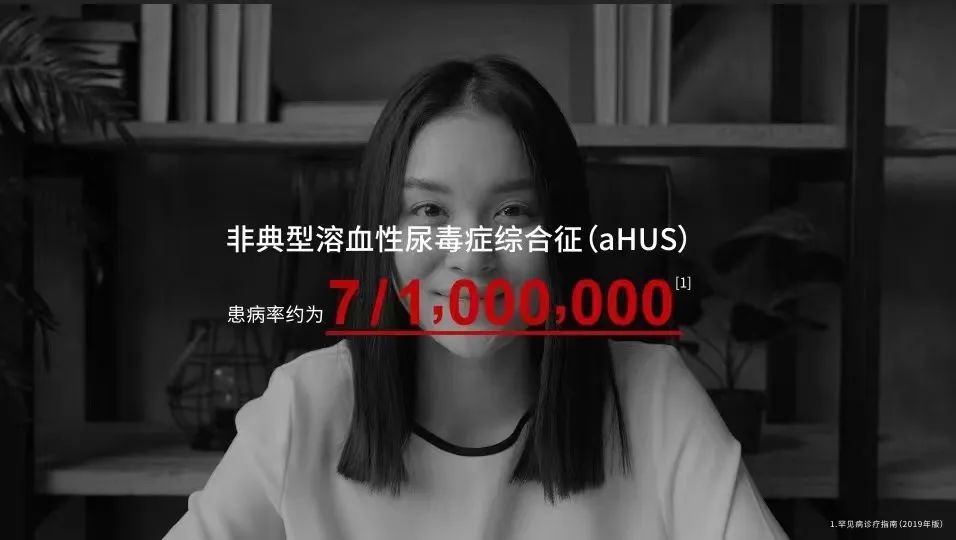Three months 40 plasma replacement: What did their reversal life go through
Author:China News Weekly Time:2022.09.24
Perhaps the disease of acute death
The patient does not know, and the doctor may not know
Yuan Meng (pseudonym), who had just given birth to the baby, was in a huge reversal of life within 24 hours.
At the beginning, it was just back pain, and soon had abrupt renal failure, heart enlargement, suffering, and could not bed. A large amount of hemolytic dissolving, anemia, heart failure, endangered death.
"This is a special type of acute dangerous diseases that only occur after pregnant women's production. Postpartum atypical hemolytic uremia syndrome is a special type of atypical hemolytic uremia syndrome (AHUS)." Zhao Minghui said that the so-called AHUS is a medium-sized thrombosis microvascular disease. The global prevalence is only 7/1 million

AHUS is also good at children. Liu Xiaorong, director of the Department of Kidney Department of Beijing Children's Hospital affiliated to the Capital Medical University, has been studying in a queue on the onset of AHUS children's onset since 2012. In her opinion, due to genetic and immune factors, AHUS children's onset is higher than adults, and the acute mortality rate The incidence of chronic kidney disease is higher.
Looking back on the medical experience of more than ten years, Zhao Minghui and Liu Xiaorong have experienced the era of AHUS without medicine and have witnessed the "important moment" of many emergency patients' lives. Those who have emerged in 24 hours have experienced, and how we should diagnose and treat the patient and doctor who are still very strange to be very unfamiliar. The two doctors have stories to tell--
40 plasma replacement,
Still reached the step of dialysis
Speaker: Zhao Minghui
What happened more than ten years ago had a great impact on me. Yuan Meng, a postpartum mother who was in critical condition. The next day after she gave birth to her child, she suddenly had back pain, no urine, and hemolysis. The so -called hemolytic dissolving is the rupture of red blood cells and the overflow of hemoglobin. A large amount of hemolysis can cause patients with heart failure and kidney failure in the short term.
At that time, she first went to a hospital in Tianjin. The diagnosis was very clear. It was a special type of AHUS. The name of this disease is strange. After giving birth to a child, hemolysis has uremia, and it is terrible to put it in any family.
When I found us, her situation was very serious. With the hepatoblasty, the doctor could touch it with his hands, and the heart was getting bigger and bigger. Heart failure is a bit like the feeling of dying of respiratory failure, which feels very terrible.
This is the main clinical manifestation of the acute seizures of thrombosis (TMA). However, TMA is a set of clinical pathological syndrome. In addition to AHUS, it also includes various forms such as TTP (thrombotic platelet reduction purpura), HUS (typical hemolytic uremia syndrome), and secondary TMA. Due to different forms, characteristics and symptoms may overlap, the diagnosis of AHUS is particularly difficult. AHUS is a rare and extreme situation of TMA, especially during pregnancy. Because the blood vessel wall and glomerular capillary become thicker during pregnancy, it is prone to proteinuria, which is the manifestation of TMA in itself. Entering the childbirth, once the mother's immune system, including the wrong body, believes that the placenta is wrong, the immune response will be issued. The excessive activation of the tonic system will start to launch an attack.
Fortunately, Yuan Meng's diagnosis at the time was very timely, and he immediately performed plasma replacement treatment. This was the only treatment method at the time. Every time she finished her heart, the hemolytic and platelet index decreased, and she could lie flat, but it didn't take long.
We guess she might have a secondary immune response, but at the time, she could not do related testing, so they could only treat it in a way to cure. We used a large dose of glucocorticoids for three consecutive days. It really interrupted the vicious cycle. The serum creatinine was maintained at about 300 μmol/L.
In less than 3 months, Yuan Meng did more than 40 plasma replacements, relying on dialysis machines, led her blood to the body, and replaced with fresh, healthy plasma, which was a huge pain. But unfortunately, we only blocked the acute attack. Her kidneys had been destroyed to a certain extent. Two or three years later, they went to uremia and performed dialysis.

This incident has a huge impact on me. We really do our best to treat it, but the result is still not good. If there is already a supplemental drug, maybe the situation will be much better, but there is no "if".
We have also encountered AHUS caused by malignant hypertension. A patient was diagnosed as uremia first. Everyone said that he was chronic and it depends on how to maintain it. But in fact, the clues in the laboratory indicators remind us that we are "long -hearted", such as the platelets fall to 100,000/ml, the hemoglobin is about 10 grams, and the hemolytic anemia. At this time, as long as the doctor asks a more headache, how much blood pressure can be over half a year, or let the patients directly measure blood pressure, let the patient check the bottom of the eyes and measure the content of the lactate (LDH) in the blood Confirm AHUS and then take targeted treatment immediately. Looking back, AHUS is a rare disease, with limited treatment methods, leading about half of people to develop uremia. But in fact, the main reason is that many doctors have never heard of this disease clinically, and even know very little about TMA, let alone how to cure it.
But I always believe that as long as the whole society, especially doctors, pay attention to this rare disease and recognize this clinical pathological syndrome, can be diagnosed; the diagnosis may become a patient with chronic uremia into acute thrombosis. In patients with microvascular disease, there is another opportunity for treatment.
Parents have to give up,
But we still want a chance
Speaker: Liu Xiaorong
Four or five years ago, I have been diagnosed with an AHUS child. When the child was 12 years old, when he was transferred to our hospital from other places, the situation was very critical, kidney failure, less urine, heart failure, shortness of breath, accompanied by lung infection, hemolysis was very serious, suffocating, vomiting, bleeding points on the body, and accompanied There are convulsions. It had been treated for two weeks before the child turned, but the effect was not good, and due to plasma allergies, severe rash also caused severe rash. At that time, the parents had no confidence in the treatment and wanted to give up.
We immediately performed the H factor antibody detection and genetic testing for the child. We recommend continuing plasma replacement and hemodialysis, but parents refused because the local doctor told him that he was considered that the child was pneumococcal infection caused by pneumonia. However, AHUS infection caused by pneumonia, most of which occurred in infants and young children. This child is definitely not, but a positive AHUS with H factor antibody. Timely plasma replacement can control the progress of the disease. After the cause of the cause of the cause of the H factor antibody is positive, we are also more confident to persuade parents to cooperate with adherence to plasma replacement and immunotherapy. Although they also face various treatment risks, we must work hard to give children the opportunity to save their lives and treat the kidneys.
There are many pathological mechanisms of AHUS, mainly related to genetic and immunity. A child born with postpartum hemolytic uremia mothers will carry genetic genes, but it may not necessarily occur. It is usually induced by some causes.

Since 2012, we have studied queue research on AHUS children's groups, and we typed AHUS into heredity and acquisition. Geneticity refers to a genetic mutation of the existence of bypass to regulate protein, which occurs in infants and young children within 3 years old; acquiring refers to the positive resistance of the H -factor antibody, which is related to immune factors.
After the classification, we found that different types, different causes, and different treatment methods, thus greatly improved the prognosis of AHUS children. In addition to the H factor antibody -positive, the child with a critical child is also lacking with the genetic segments of the H factor -related protein. These factors cause the child's hemolysis to continuously alleviate the hemolysis, the kidney function is performed sexually, the plasma replacement is 12 times, the hemo dissolution is controlled by control , Hematopolysis for 1 month, the renal function improves, and get rid of dialysis treatment. At the same time, hormone and immunosuppressive agents were taken for half a year. In the end, the child's hematuria and proteinuria disappeared for half a year, and the heart function was recovered after the treatment of anti -heart failure. Use only one antihypertensive drug. It can be said that we successfully saved the child's life, blocked the children's path to the uremia, and let him get rid of the dialysis machine.
The benefit of the division is that it can be more clear and precisely treating the cause, judging the prognosis, and accurate intervention for the recurrence time in the future. We also have a child with AHUS children with mutation of protein MCP gene, 4 recurrence. MCP gene mutations have a good effect on plasma replacement therapy, but the recurrence rate is very high. Each recurrence will cause the risk of chronic kidney disease, which must be treated in time. We remind parents that they must pay attention to observation. The child's complexion is not good and a little urine. We immediately go to the hospital to check the urine routine, blood routine, and biochemical, so that the child can be treated as soon as possible. We are also pleased to see that children's current blood routine, urine routine and kidney function are normal.
I do n’t know the mechanism more than ten years ago, but now we give the disease more detailed typing. Through the detection of genetic and antibody testing, we standardize the treatment of AHUS, through targeted treatment or comprehensive treatment methods, obtain positive treatment effects Essence Even though AHUS is still a critical illness, as long as he firmly treats and the confidence of victory, the hope of healing is on the road.
Make "rare" to be seen
Zhao Minghui said that the patients who are currently seen are only the tip of the iceberg, and 90%of the people under the iceberg have not been diagnosed. Not diagnosed is not because there are few people, but from more than ten years ago to today, patients, doctors, and the public's perception of the disease still insufficient.
Compared with other congenital or chronic rare diseases, AHUS's characteristics are not only "more rare", but also greater harmfulness -acute death, chronic people enter uremia. Just like postpartum hemolytic uremia syndrome, because it only appears in the short term after production, it cannot be prevented. There are many children patients, and some of them are even directly regarded as infectious diseases, and there is no further diagnosis and missed the golden timing of treatment. Many people think that rare diseases are because of "rare", but in fact "rare" is a medical needs that are far from met. In the past, those who could be diagnosed because of the single treatment methods could only live "blood change" life through plasma, and often a week or even two or three days of dialysis, it was also a heavy burden on patients and family members. From the perspective of blood conditions and prognosis, plasma replacement can only be emergency, and it is impossible to apply for a long time.
Any small group should not be abandoned, and the smaller probability of illness is a large number by 1.4 billion. Fortunately, with the rapid progress of the pathogenesis mechanism in recent years, the key role of the abnormal activation of the body in the AHUS pathogenesis has been confirmed, becoming a new target for therapeutic treatment, and innovative drugs represented by the supplementary inhibitor will be used for clinical clinical clinical Essence
From the "helpless move" in the past to the emergence of new treatment drugs today, many people's efforts are explored. With the update of drug development and treatment methods, I believe that this rare disease can also be discovered, early intervention, early treatment, early treatment, and early treatment. Strive for patients' greatest survival benefits.
The premise of all this is "knowing". On September 24th World AHUS Caring Day, we hope that through the stories of two doctors, more people can understand and pay attention to the atypical hemolytic uremia syndrome AHUS, so that "rare" will be seen and the redness of life is guarded.
Disclaimer: This article is only the purpose of information transmission and knowledge popularization. If you have any questions, please consult medical professionals.
references:
1. Rare disease diagnosis and treatment guide (2019 edition)
2. Liu Xiaorong, Shen Ying, Fan Jianfeng, etc. Chinese children atypical hemolytic uremia syndrome diagnosis specifications expert consensus [J].
3.AfShar-Kharghanv.HematologyAmsocheMato CPROGRAM.2016; 2016 (1): 217-225 Author: Liu Huan
Edit: Ma Min
Operation editor: Wang Lin
- END -
Report on the investigation and disposal of 30 newly added cases and 74 non -symptoms in Bijie City
September 22, 2022 0-24 o'clock: 30 newly confirmed cases in the city (1 case of 1 case of Qixingguan District, 29 cases of weakin County); 74 newly added infected infections (3 cases of Qixingguan Di...
[Health Hall] Today at 17:25, the "Dead Crisis Behind the Gate of" Life and Death ""

Tian Wen, Director of Surgery, General Medicine of the General Surgery Department ...